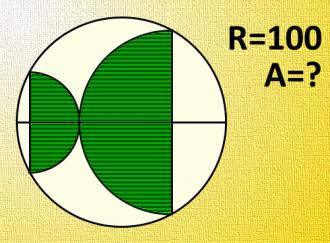Find the area of the green part
Find the area of the green part if diameter of the circle is R=100. Express result to the accuracy of 3 decimal.Correct answers: 38
The first user who solved this task is Roxana zavari.
#brainteasers #math

Church Bulletin Bloopers
The Associate Minister unveiled the church's new tithing campaign slogan last Sunday: "I Upped My Pledge - Up Yours."Our next song is "Angels We Have Heard Get High."Don't let worry kill you, let the church help.For those of you who have children and don't know it, we have a nursery downstairs.This being Easter Sunday, we will ask Mrs. Lewis to come forward and lay an egg on the altar.

